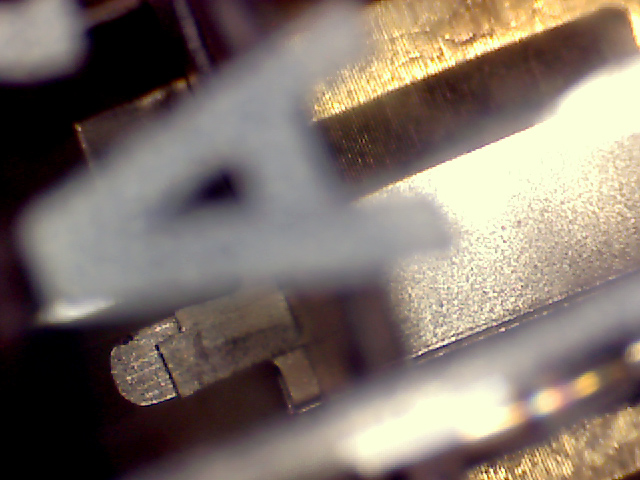|
During the last twelve months the Mullard Valve Company have introduced a series of valves known as 'frame grid' valves. These are the latest developments in the quest for high stage gain in radio frequency amplifiers operating at television frequencies.

A photomicrograph of the frame grid in an A2688 triode
It can be shown theoretically that the gain of any radio frequency or intermediate frequency amplifier is almost exactly proportional to the mutual conductance of the valve used. Some of the first screen grid valves to be manufactured (such as the ARS6 about 1927) had a mutual conductance of about 0.6 mA/Volt. The conventional high gain sharp cut-off pentodes such as the EF80 and the 6AC7 have a mutual conductance of about 7 to 10 mA/Volt. In the frame grid range, however, the EF184 has a mutual conductance of about 15 mA/volt. As a high frequency amplifier it will therefore give about twice the gain of a conventional high gain pentode, but this gain can be varied only within a limited range by the application of bias.
The advantages of the variable-mu EF183 are even more striking. The conventional 6K7 or EF39 type of valve has a maximum mutual conductance of about 2mA/volt.
The miniature 6BA6 gives a higher gain as an RF amplifier because its maximum mutual conductance is about 4.4 mA/Volt. The EF183, however, has a maximum mutual conductance of about 13 mA/Volt. It will therefore give about three times the gain of a 6BA6 or about seven times the gain of a 6K7. The gain of an EFI83 amplifier can be varied over a wide range of values.
Frame Grid Construction
The mutual conductance of a valve can be increased by a suitable choice of dimensions for the control grid. In order to obtain a high mutual conductance, the grid must be wound with very fine wire closely spaced and should be placed very near to the cathode in order that it can exert the maximum control over the electron stream. In addition, the dimensions of the grid must be very closely controlled, its manufacture becoming a matter of precision workmanship.
The grid winding in conventional valves must be fairly thick so that it is strong enough to keep the supporting wires at the correct distance apart; this limiting the mutual conductance obtainable. In the frame grid valves, however, these difficulties are overcome by closely winding a very fine wire grid under tension on an accurately made frame of stout wires. The grid supporting wires are rigidly fixed to each other by means of sturdy cross rods.
Other Advantages
The input capacity of the frame grid valves is similar to that of conventional valves and they can therefore be used as RF amplifiers. They have an input impedance of about 10kΩ at 40 MHz. As RF amplifiers, the frame grid valves not only give high gain but they also have the advantage that the signal to noise ratio, at the output of the stage, may be considerably greater than that at the output of a similar stage using a conventional valve. The frame grid double triode ECC189 is intended for use as a very low noise RF cascode amplifier at VHF. It has a mutual conductance of 12.5 mA/volt.
The control characteristics of the frame grid valves are very good. For instance the PCC89 will handle about five times the signal which can be handled by a PCC84 Without any cross modulation.
The danger of a valve becoming microphonic is less in the frame grid series because the fine wires under tension resonate at a frequency well above audio frequencies.
TV Receivers
Frame grid valves are especially useful in TV receivers. The four valves shown at the bottom of the page have been especially designed for this purpose. A receiver using the frame grid valves PCC89 (RF amplifier), PCF86 (mixer) and the EF183 (IF amplifier) will be about eight times as sensitive (18dB) as a receiver using the PCC84, PCF80 and the EF85.
In fringe areas the use of frame grid valves may render the addition of extra front end amplification to a TV receiver unnecessary. Alternatively, if the local signal strength is fairly reasonable, a receiver using frame grid RF and mixer valves could employ one valve less (an IF amplifier) than a similar receiver employing conventional valves. As a matter of economics this is bound to interest TV receiver manufacturers.
In addition to the above advantages, the use of frame grid valves in TV receivers will greatly reduce the possibility of sound break-through in the vision channel due to cross modulation.
Conclusion
It is to be expected that frame grid valves will have a very wide application in the future, especially in TV and other high frequency receivers. It is, however, somewhat doubtful if they will ever be used to any great extent in the ordinary 4+1 superhets, as the extra gain is not really required for most purposes.
The writer would like to thank Messrs. Mullard Ltd. for sending him details about some of their frame grid valves.
Valve Types
PCC89
PCC89: variable-mu RF double triode for use as cascode amplifier.
PCF86
PCF86: triode-pentode frequency changer.
EF183
EF183: variable-mu RF pentode for use as AGC controlled IF amplifier.
EF184
EFI84: straight pentode for use as IF amplifier.
The Mullard series of Frame Grid valves intended for use in TV receivers. All of the above valves require a heater current of 300 mA and are therefore suitable for AC/DC series operation.
|